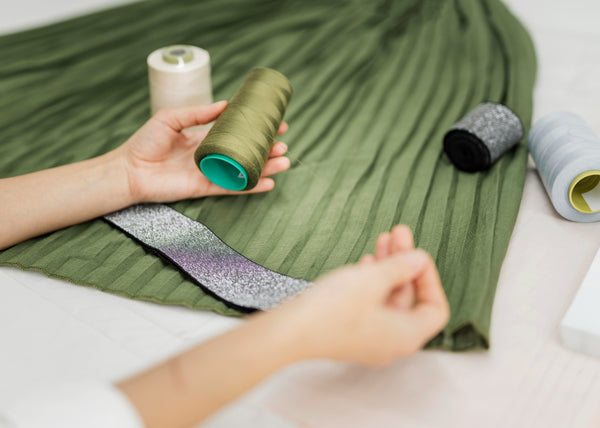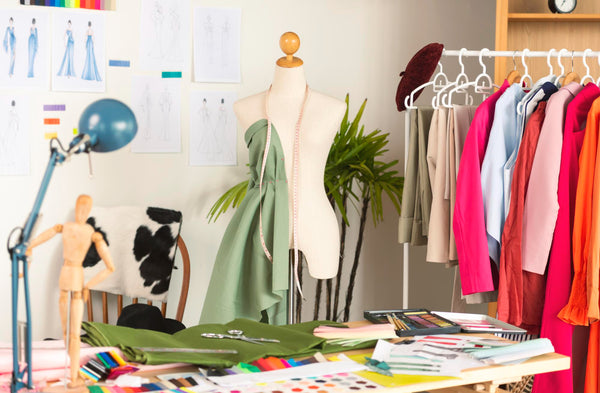History of Rayon Fabric
Rayon, the first synthetic fibre, originated in the late 19th century. In 1855, French scientist Count Hilaire de Chardonnet created the precursor called "Chardonnet silk." However, commercial production began in 1910 with the American Viscose Company. Dubbed initially "artificial silk," rayon gained popularity for its silk-like qualities.
Over the years, advancements in production processes refined its texture and uses. Rayon became a versatile fabric, serving various applications from fashion to industrial purposes. Its history represents a significant milestone in textile innovation, marking the advent of artificial fibres that complemented and, in some cases, surpassed natural counterparts.
Production Process of Rayon Fabric
Rayon fabric is produced through a highly specialised process that involves regenerating cellulose from natural sources like wood pulp or cotton linters.
The cellulose is chemically treated to create a viscose solution, which is then extruded through tiny spinnerets to form continuous strands of regenerated cellulose fibres. These fibres are further processed, treated, and spun into yarn for weaving or knitting into the final rayon fabric.
Examples of Rayon Fabric
Rayon fabric comes in several types, each with distinct qualities like:
- Viscose Rayon: Known for its silk-like texture and drape, it is commonly used in clothing.
- Modal Rayon: Blended with other fibres, offering enhanced softness, breathability, and colour retention.
- Lyocell (Tencel): Renowned for its eco-friendly production process, providing a smooth and breathable fabric.
- High-Tenacity Rayon: Exhibiting increased strength, ideal for industrial and heavy-duty applications.
- Cupro: Boasting a luxurious feel, often used in high-end fashion, blending comfort with elegance. Exploring these rayon variants reveals a spectrum of textures and applications.
Types of Rayon Fabric
Rayon, a versatile semi-synthetic fabric, encompasses various types, each distinguished by its unique properties and manufacturing processes. From the smooth and lustrous characteristics of viscose to the durability of high-tenacity rayon, exploring the diverse types of rayon fabric unveils a rich tapestry of options catering to different needs, preferences, and applications in the ever-evolving world of textiles.

Features & Characteristics of Rayon Fabric
Rayon fabric is celebrated for its unique features, combining the best qualities of natural and synthetic fibres. Notable characteristics include a soft and smooth texture resembling silk, making it a popular choice for clothing. Rayon is highly absorbent, vividly absorbing vibrant colours. Its breathable nature provides comfort and drapes elegantly, adding fluidity to garments.
While versatile, Rayon can imitate the look and feel of other fibres like cotton, linen, or silk. Despite its delicate appearance, Rayon exhibits reasonable durability. However, it can wrinkle easily. Rayon's adaptability in various blends and types, such as viscose, modal, and lyocell, showcases its versatility in meeting diverse fashion and functional needs.
Uses of Rayon Fabric
Rayon fabric, known for its silky smooth texture and affordable luxury, finds versatile applications across various industries. Common rayon fabric examples include viscose (known for silk-like qualities) and modal (often used for soft clothing).
Rayon is extensively used in clothing, from dresses and blouses to lingerie and loungewear. Rayon's breathability and drape make it suitable for home furnishings like curtains, upholstery, and bedding. Additionally, it's employed in the production of linings, ribbons, and even industrial filters, showcasing its adaptability to diverse needs.
Pros and Cons of Rayon Fabric
Here are a few pros and cons of the rayon fabric:
|
Pros |
Cons |
|
Soft and silky texture, similar to natural fibres |
Prone to shrinking and wrinkling |
|
Breathable and comfortable to wear |
Poor resistance to sunlight and fading |
|
Versatile for various apparel and home textiles |
Not as durable as natural fibres like cotton or linen |
|
Affordable and cost-effective alternative to silk |
Requires careful laundering and handling |
|
Drapes well and provides a luxurious feel |
May develop an unpleasant odour if not properly cared for |
|
Available in a wide range of colours and patterns |
It can be less environmentally friendly due to chemical processing |
Rayon Fabric Styles
Rayon fabric, renowned for its versatility, lends itself to various styles, enhancing the fashion landscape. In its viscose form, it graces elegant evening gowns, capturing the essence of silk with a more affordable touch. Modal Rayon, blended for enhanced softness, finds a place in casual wear like t-shirts and loungewear.
Lyocell, known as Tencel, offers a sustainable option for eco-conscious fashion, contributing to various chic styles. Whether draped into flowing dresses or tailored into sophisticated suits, the diverse styles of rayon fabrics cater to a spectrum of aesthetics, blending comfort, fashion, and environmental consciousness.
What is Rayon Fabric Made of?
Rayon is a semi-synthetic fabric from cellulose fibres, typically derived from wood pulp. The production involves a process known as the viscose process, where cellulose undergoes chemical treatments to create a viscous liquid. This liquid is then extruded through spinnerets to form fibres solidified into threads.
The resulting rayon fabric retains the softness and drape of natural fibres while offering versatility akin to synthetic materials. Using renewable resources like wood pulp aligns with eco-friendly practices, contributing to Rayon's popularity as a sustainable textile option in the fashion industry.

What Does Rayon Fabric Feel Like?
Rayon fabric has a luxurious and soft feel, often resembling the smoothness of silk. Its texture is relaxed and comfortable against the skin, providing a pleasant tactile experience. Rayon is known for its draping quality, allowing garments to fall gracefully and flow elegantly.
The lightweight fabric contributes to a breathable and airy sensation, making it suitable for various climates. The hand feel may vary depending on the type of Rayon, such as viscose or modal. Still, in general, Rayon offers a gentle and silky touch that adds a touch of sophistication to clothing and other textile products.
Is Rayon Sustainable?
Rayon's sustainability varies based on production methods. Traditional viscose rayon involves chemical processes impacting the environment. However, newer technologies, like those used in lyocell (Tencel), offer a more sustainable alternative. Lyocell production employs a closed-loop process, recycling solvents and minimising environmental impact. While traditional Rayon may raise environmental concerns, choosing lyocell or other eco-friendly variants aligns with sustainable practices, demonstrating that the overall sustainability of Rayon depends on the specific type and manufacturing processes employed.
Care Instructions for Rayon Fabric
Rayon fabric, although luxurious, requires proper care to maintain its beauty and longevity. Follow these care instructions to ensure any types of rayon garments and textiles remain in pristine condition:
- Gentle washing with mild detergent in cool or lukewarm water is recommended.
- Avoid using bleach or harsh chemicals, as they can damage the fibres.
- Air drying or line drying is preferable to prevent shrinkage or fading.
- Iron on a low to medium heat setting while slightly damp for best results.
- Avoid excessive exposure to sunlight, which can cause discolouration over time.
FAQs about Rayon Fabric Online
1. Is Rayon Breathable?
Ans: Yes, Rayon is breathable. Its natural fibres allow air circulation, making it comfortable for warm weather.
2. Is 100% Rayon a Good Fabric?
Ans: Yes, 100% rayon is a good fabric. It is soft, drapes well, and offers a luxurious feel, often resembling natural fibres like silk.
3. What is Rayon Fabric Suitable For?
Ans: Due to its comfort and breathability, Rayon suits various clothing items, including dresses, blouses, shirts, and summer apparel.
4. What is the Best Quality of Rayon?
Ans: The best quality of Rayon often depends on the specific type. Lyocell (Tencel) is renowned for its eco-friendly production and soft texture.
5. Is Rayon Good to Wear in Winter?
Ans: While not insulating as wool, Rayon can be worn in winter, especially in layered outfits. Its breathability makes it suitable for moderate cold temperatures.
 Call Us
Call Us

